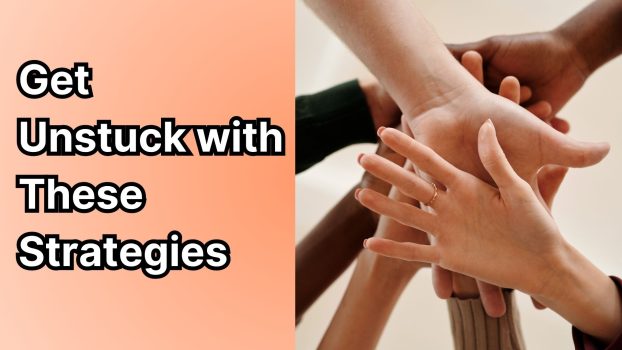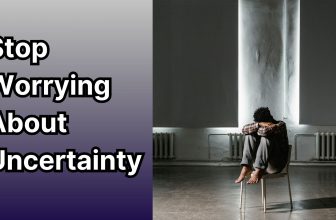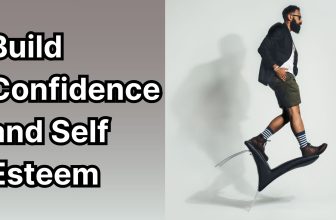Feeling stuck in life is a common experience that nearly everyone faces at some point. Whether it’s in our career, relationships, or personal goals, the frustrating sensation of being unable to move forward can leave us feeling trapped and uncertain about what steps to take next. If you’ve ever asked yourself, “How do I get unstuck?”, take comfort in knowing you’re not alone — I have been there as well, and there are effective strategies to help you overcome this inertia.
According to psychologist Adam Alter, PhD, being stuck often stems from mental or emotional roadblocks. The good news is that with the right approach, you can identify what’s holding you back and start taking small yet meaningful steps to regain momentum. The key lies in understanding the root causes of your stuck feeling, setting clear goals, and making deliberate shifts in your mindset and daily routine.
This guide I created will provide actionable steps to help you move forward and create the change you desire in life.
Identify the Root Cause
Reflect on Your Emotions and Experiences
To begin getting unstuck, it’s important to first understand why you feel that way. Reflect deeply on your emotions and experiences.
Are you overwhelmed by cognitive overload, burnout, or perhaps unconscious self-sabotage? Sometimes fear—whether of failure, the unknown, or making wrong decisions—can paralyze you and keep you in place. Negative thoughts and self-doubt can also form invisible barriers, preventing you from taking action.
By acknowledging these feelings honestly, you create clarity about what’s holding you back. This process might require you to face uncomfortable truths, but it’s a fundamental step to uncovering your “sticking point” and regaining control over your mental health and motivation.
Analyze Your Environment and Relationships
Next, look around at your life context. Your environment and the people you spend time with—whether friends, family members, or colleagues—can have a profound impact on your feelings of stuckness.
Is your environment supportive and encouraging of the change you want to make, or is it fostering negative patterns and judgment? Sometimes, we remain stuck because of unconscious influences from those around us or because we lack necessary resources like time, emotional support, or space to be creative.
Conducting a kind of “friction audit” of your surroundings helps you evaluate what external factors keep you tethered and what can be altered to create better momentum for change in your life.
Set Clear and Achievable Goals
Define What Success Looks Like
When you’re feeling stuck, a key way to move forward is by clearly defining what success means for you personally. Rather than relying on vague hopes or general desires like “change life” or “feel better,” try to visualize the end result — what will it look like when you reach your goal? This approach, often recommended by experts and supported by research, helps remove uncertainty and the overwhelming nature of the process.
Consider the specifics: What does a good day feel like? What small achievements will signal progress?
Defining success in concrete terms can give your goals clarity and purpose, making it easier to commit and stay motivated.
Break It Down into Smaller Steps
Big goals can feel daunting and trigger the frustrating “life stuck” feeling, but the secret to overcoming this is breaking them down into tiny, manageable actions. Focus on taking small steps forward rather than attempting to leap toward the finish line all at once.
For example, if your goal is to start a coaching career or change a long-standing habit, begin with the smallest possible task — like researching one new idea or setting up a plan for just 10 minutes a day. These micro-actions build momentum, generate dopamine boosts from progress, and reduce the mental friction that often keeps people stuck. Remember, progress is progress, even if it feels slow, and accumulating small wins helps you keep going when motivation wanes.
Change Your Routine and Perspective
Alter Your Daily Routine
Sometimes, the reason you feel stuck isn’t only internal — it’s also about the patterns you repeat every day. Changing your routine can break the cycle of monotony that keeps you tethered in place. Consider introducing new habits that support your mental and physical well-being, such as starting your day with a few minutes of meditation, hydration, or light exercise.
These small but intentional shifts can build a positive framework for your day and make you feel more energized and in control. It’s important to regularly reassess your routines, especially as life changes, and be willing to toss out the old habits that no longer serve your goals or happiness.
A flexible, consciously designed routine can help you move away from autopilot and gain renewed momentum.
Seek Inspirational and Educational Resources
Another powerful way to shift your perspective is by surrounding yourself with inspiration and knowledge that aligns with your goals. This could include reading books by experts like Adam Alter, PhD, who explore why people feel stuck and how to move forward, or listening to podcasts that stimulate new ideas and motivation. Sometimes, exposing yourself to different viewpoints, stories of change, or expert advice can unlock new ways of thinking and spark creativity that was previously blocked.
Learning also fuels your confidence and helps replace negative thoughts with hopeful, solution-oriented perspectives. This mental “unfocusing” — giving your brain space to wander and absorb — can boost problem-solving and help you break free from “ritualized” thinking patterns.
Conclusion
Feeling stuck is a common part of the human experience, but it doesn’t have to be permanent. Remember to first identify the root cause by reflecting on your emotions and environment.
Then, set clear and achievable goals by defining what success looks like and breaking it into smaller steps. Finally, changing your routine and seeking new perspectives can trigger the momentum you need to move forward.
Take action today — even the smallest step can alter your path. Your journey to a more fulfilling life begins with the decision to get unstuck and keep going.
FAQ
What are the most common emotional triggers that contribute to the feeling of being trapped?
The most common emotional triggers contributing to the feeling of being trapped include feeling invisible, dismissed, or abandoned, which stir insecurity and helplessness. Other triggers such as rejection, loss of control, criticism, and unresolved trauma evoke emotions like anger, sadness, fear, and frustration. These triggers often stem from past experiences and unmet emotional needs.
How can recognizing inner passivity help me break free from feeling stuck?
Recognizing inner passivity reveals how unconscious submission to self-criticism and unresolved negative emotions can trap us. This awareness helps identify symptoms like indecision and low self-worth, fostering self-regulation and goal-setting to empower proactive change.
By confronting inner passivity, we reclaim agency, break cycles of helplessness, and overcome the feeling of being stuck.
What practical steps can I take to regain control when I feel overwhelmed by hopelessness in my situation?
To regain control when overwhelmed by hopelessness, take practical steps such as breaking challenges into small, manageable actions and celebrating each achievement. Express feelings through journaling or creative outlets, reframe negative thoughts to see future possibilities, and do the opposite of hopeless urges, like getting out of bed. Staying connected and seeking support can also help. These actions build momentum and restore hope.
Which self-care activities are most effective in shifting my emotional state and helping me move forward?
The most effective self-care activities for shifting your emotional state include mindfulness practices such as meditation and deep breathing, journaling your feelings, practicing gratitude and positive affirmations, spending time in nature, and setting healthy boundaries. These activities help you process emotions, calm your mind, and foster self-love and acceptance. Engaging in sensory activities like listening to music, taking a bath, or changing your environment can also uplift your mood and promote relaxation.
Combining these methods supports emotional balance and forward movement.







